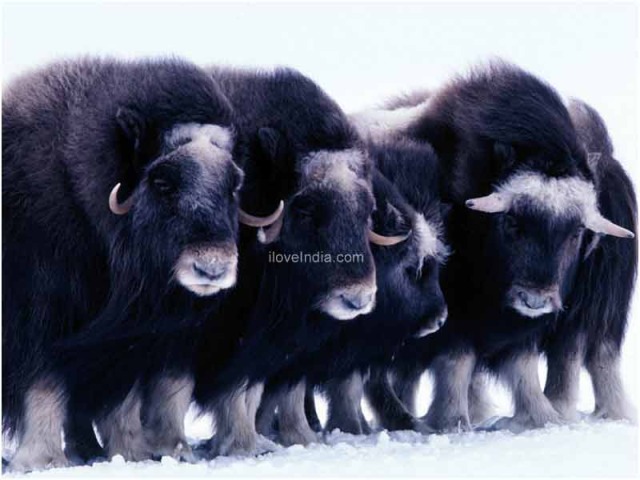Musk oxen, belonging to 'Bovidae' family, are native to the Arctic areas of Canada, Greenland and Alaska. Let us explore some interesting facts and amazing information on musk oxen.
Facts About Musk Oxen
Native to the Arctic areas of Canada, Greenland and Alaska, musk oxen represent an animal belonging to the 'Bovidae' family, which also includes cattle, bison, water buffalo, antelopes, gazelles, sheep and goats. They are mostly found to inhabit wet areas, such as river valleys. However, in the winter season, they move over to the higher elevations, in order to avoid deep snow. Musk oxen survive on a diet of grasses, reeds, sedges, and other ground plants. Though easily fed in the summers, they have to dig through snow to reach their food in the winter season. They live in wet areas during the summers, such as river valleys and avoid elevated grounds which are covered with snow. Musk oxen are not territorial but they mark their trails with the help of their pre-orbital glands. Want to know some more interesting facts and amazing information on musk oxen? The following lines will serve your needs perfectly. 

Fast Facts
Binomial Name: Ovibos moschatus
Kingdom: Animalia
Phylum: Chordata
Class: Mammalia
Order: Artiodactyla
Family: Bovidae
Subfamily: Caprinae
Genus: Ovibos
Species: O. moschatus
Sub-species: Caprinae
Height: Up to 1.2 m (3 ft 11.2 in)
Length: Males - Up to 200 to 250 cm (78.7 to 98.4 in), Females - Up to 135 to 200 cm (53.1 to 78.7 in)
Weight: 180 to 400 kg (397 to 882 lb)
Diet: Herbivorous
Age of Maturity: Males - 5 years, Females - 2 years
Gestation Period: 8-9 months
Number of Offspring: One
Interesting & Fun Facts About Musk Oxen
- Musk oxen have been named by the strong odor that is emitted by the male members (bulls) of their species. This 'musky' odor is used to attract females (cows) during mating season.
- Unlike what most of the people tends to believe, musk oxen are more closely related to sheep and goats than to oxen.
- Musk oxen are equipped with a thick coat, made up of a mixture of black, gray, and brown guard hair. Their hair is so long that it almost reaches the ground.
- The wool of a musk ox commands a very high price, owing to its softness, length, and insulative value.
- Though it is a very rare occurrence, there have been a few instances of 'white musk ox' being spotted in the Queen Maud Gulf Bird Sanctuary.
- Social animals, by their very nature, musk oxen are known to live in herds, which comprise of adults of both sexes, along with young animals.
- In a typical musk oxen herd, you will find around 10–20 animals. However, at times, the number of members might go up to 70 as well.
- The mating season of musk oxen falls in mid-August, around which time the males are very aggressive and compete for dominance over the group. The dominant bull drives other adult males out of the group.
- Though the young ones of musk oxen nurse for a year, they might start eating grasses not more than a week after birth.
- The main predator of musk oxen comprises of wolves. Apart from that, they are also hunted by Brown, Grizzly and Polar bears.
- It is believed that musk oxen, rather their ancestors, migrated to North America around 200,000 to 90,000 years ago.
- When attacked or threatened, the bulls (male) and cows (female) tend to form a stationary ring around the calves, protecting them.
- The musk oxen females are more aggressive when they are pregnant. They decide the course of the journey of the herd including the places to rest.
- The musk oxen and the caribou are the only two hoofed animals to have survived the Pleistocene Era, 10,000 years ago.
- The horns of musk oxen do not shed and grow larger each year.
- The female musk oxen are called cows and the males are called bulls.
- The life-span of a these animals is 20-25 years. Musk oxen fight a lot among themselves, for dominance, and in the process many weak or young males get killed. Some others, who may have survived the fight, may not be able to survive the injuries and die early.
- Musk oxen have sharp hooves which enables them to dig through the snow. Usually in the winters, a thick blanket snow covers the vegetation, the only source food for these animals. It is then they use their hooves to unearth the plants submerged in the snow.
See also
More from iloveindia.com
- Home Remedies | Ayurveda | Vastu | Yoga | Feng Shui | Tattoos | Fitness | Garden | Nutrition | Parenting | Bikes | Cars | Baby Care | Indian Weddings | Festivals | Party ideas | Horoscope 2015 | Pets | Finance | Figures of Speech | Hotels in India : Delhi | Hyderabad | Chennai | Mumbai | Kolkata | Bangalore | Ahmedabad | Jaipur
- Contact Us Careers Disclaimer Privacy Policy Advertise With Us Lifestyle Sitemap Copyright iloveindia.com. All Rights Reserved.




